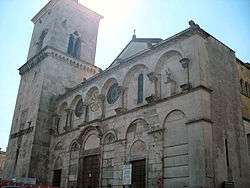Benevento Cathedral
| Benevento Cathedral | |
|---|---|
 Benevento Cathedral. | |
| Basic information | |
| Location | Benevento, Italy |
| Geographic coordinates | 41°7′54.03″N 14°46′28.12″E / 41.1316750°N 14.7744778°ECoordinates: 41°7′54.03″N 14°46′28.12″E / 41.1316750°N 14.7744778°E |
| Affiliation | Roman Catholic Church |
| Province | Archdiocese of Benevento |
| Ecclesiastical or organizational status | Cathedral |
| Status | Active |
| Architectural description | |
| Architectural type | Church |
| Architectural style | Romanesque |
| Groundbreaking | 8th century |
Benevento Cathedral (Italian: Cattedrale di Santa Maria Assunta or Duomo di Benevento) is a religious building in Benevento, southern Italy. The church dates to the Lombard foundation of the Duchy of Benevento, in the late 8th century, but after its destruction during Allied bombings in the course of World War II, it was largely rebuilt in the 1960s.
History
The Cathedral is in the site of the first Christian church in Benevento, where once was the Roman capitol. In general the foundation is dated to the early 7th century, although later, under duke Arechis II, it was enlarged in the 8th century into the edifice which is the current one's crypt. Around 830 the Lombard prince Sico I of Benevento enlarged the primitive church with a nave and two aisles and placed classical-style columns, which characterized the cathedral until its destruction in 1943.

In the 10th century, when Benevento became an archbishopric seat, bishop Roffredo enlarged the church, although it missed a façade and a bell tower till the 13th century. In November 1456 the nearly completed cathedral was damaged by an earthquake. It was repaired with the help of Pope Pius II and consecrated on 4 November 1473. Perhaps during this restoration it received two further aisles. Other modifications were added before a new reconsecration in 1687. Other earthquakes damaged the church in 1688 and 1702, after which it was brought to the appearance it kept until the Allied destroyed it in World War II.
The church was rebuilt in the 1950s and 1960s, under the design of Paolo Rossi De Paoli.
Description
The modern church has maintained the Romanesque façade and bell tower. Also preserved is the crypt of the primitive church, with remains of 14th-century frescoes. All the rest belongs to the modern edifice completed in the 1960s.
The façade, dating to the late 13th century, is entirely in white marble, inspired by contemporary Pisan structures. It has two orders with six arcades, which are less deep in the lower one. The main portal is enclosed in an architrave and two richly decorated imposts. The side portals' imposts are re-used Roman architraves. The upper arcades form a loggia, and are separated by decorated columns. The arcade above the portal has a rose windows with twelve ray columns and a mosaic of the Mystic Lamb. The other arcades have oculi and a single mullioned window. The rightmost one, finally, has a depiction of "Knight" from the 13th century, placed there after the destruction of the original tomb it decorated.
The squared and sturdy bell tower was erected by archbishop Roman Capodiferro since 11 February 1279. The front has a frieze with 17 Roman memorial stones, while the western side features has remains of a Roman labarum in gilt metal. At the base of the east side is a relief representing a wild boar with a crown of laurel: this perhaps hints to the foundation of the city, or was the totemic animal of the Samnites living in the area before the Roman conquest. The bell cell has four double mullioned windows.
The interior, in modern style, houses however several historical features: these include a large statue of St. Bartholomew (early 14th century), some 18th-century artworks which escaped the destruction of 1943, and the 7th–8th-century crypt.
Sources
- Rotili, Mario (1952). L'arte nel Sannio. Benevento: E.P.T.
- Abbate, Francesco (1997). Storia dell'arte nell'Italia meridionale. Rome: Donzelli.